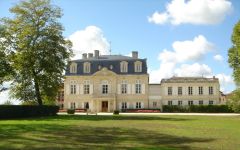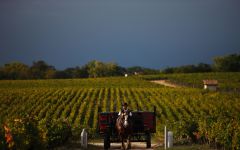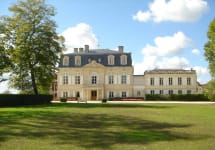Chateau Pontet-Canet 2016
-
Wine
Enthusiast -
Robert
Parker - Decanter
-
Jeb
Dunnuck -
James
Suckling -
Wine
Spectator



Product Details
Your Rating
Somm Note
Winemaker Notes
What strikes the taster immediately is the energy these wines display, the expression of tension and intensity: they are bright and brilliant, as though freed of any constraint. Their internal balance combines contained power, uncommon precision of fruit and undeniable class. They seduce by their full-bodied fruit, the finesse of their mouthfeel and their natural elegance, delivering a natural emotion which enhances their seductive charm.
Professional Ratings
-
Wine Enthusiast
A voluptuous wine, this is rich and fruity yet properly balanced by a magnificent structure. Pure, crisp and packed with a black currant flavor, this will be a remarkable wine as it develops. Still young, it needs many years to develop. Don’t think about drinking before 2025.
Editors' Choice -
Robert Parker's Wine Advocate
Deep garnet-purple in color, the 2016 Pontet-Canet hits the ground running with a hedonic nose of Black Forest cake, crème de cassis and blueberry pie plus suggestions of candied violets, hoisin, chocolate mint, charcuteries and forest floor with a waft of star anise. Full-bodied, rich, profoundly layered and powerfully fruited, the palate is built like a brick house, with very firm, super ripe, grainy tannins and harmonious freshness, finishing with incredible length and depth. Still incredibly primary and yet already strutting so many layers, I wouldn't be at all surprised if this warrants the three-digit score in a few years' time.
Rating: 98+ -
Decanter
The 2016 is a vintage that shows off the best of Pontet, and is similar in feel to their 2010. Gorgeously rich right from the first nose, it opens stunningly in the glass, showing waves of tight black fruits, touches of redcurrant, liquorice and aniseed, fine tannins and mouthwatering salinity. It manages to remain balanced without losing the punch and concentration of Pauillac, rising up through the palate. It's hard not to fall in love with this wine, and it will clearly age with grace and ease. Bottled in July 2018. Drinking Window 2026 - 2042
-
Jeb Dunnuck
Reminding me of the 2010 and, I suspect, a wine that will merit a triple-digit rating in a decade or so (I tasted this on multiple occasions and thought it was perfect on one of them), the 2016 Château Pontet-Canet comes from 65% Cabernet Sauvignon, 30% Merlot, 3% Cabernet Franc, and the balance Petit Verdot that spent 16 months in 50% new French oak, 35% in concrete amphora, and the rest in second fill oak. Thrilling notes of pure crème de cassis, lead pencil shavings, crushed mint, graphite, and crushed rock notes all emerge from this deep, powerful, yet elegant Pauillac. The style of this wine has become more and more finesse-driven and pure, yet it hasn’t lost a beat on concentration or length. This singular, beautiful Pontet-Canet needs 7-8 years of cellaring (it has some accessibility today given its purity and balance) and will keep for 4-5 decades.
Rating: 98+ -
James Suckling
The aromas of ripe blackcurrants, iodine, sweet tobacco and fresh flowers are spellbinding. Full-bodied with mouth-expanding, massive and natural tannins. Impressive fruit with hints of prunes. The finish is long and powerful. Needs six to seven years to soften and come together. Try from 2025.
-
Wine Spectator
This is sappy and rich in feel, with waves of red and black currant preserves, raspberry and bitter plum coulis. The long finish drips with sweet tobacco and anise notes, while a brambly layer courses underneath. The vivacious finish kicks into second gear as the fruit and grip come together. Best from 2023 through 2038.
Other Vintages
2024-
Robert
Parker -
James
Suckling - Vinous
-
Robert
Parker -
James
Suckling -
Jeb
Dunnuck - Decanter
- Vinous
-
Jeb
Dunnuck -
James
Suckling - Decanter
-
Wine
Spectator
-
Wine
Enthusiast -
James
Suckling - Decanter
-
Jeb
Dunnuck -
Robert
Parker -
Wine
Spectator
-
James
Suckling -
Robert
Parker -
Wine
Enthusiast -
Jeb
Dunnuck - Decanter
- Vinous
-
Robert
Parker -
Wine
Enthusiast -
James
Suckling - Decanter
-
Wine
Spectator -
Jeb
Dunnuck
-
Robert
Parker -
Wine
Enthusiast -
James
Suckling -
Jeb
Dunnuck - Decanter
-
Robert
Parker -
Wine
Enthusiast -
James
Suckling -
Wine
Spectator - Decanter
-
Jeb
Dunnuck
-
James
Suckling -
Wine
Enthusiast -
Robert
Parker - Decanter
-
Jeb
Dunnuck -
Wine &
Spirits -
Wine
Spectator
-
James
Suckling - Decanter
-
Wine
Enthusiast -
Jeb
Dunnuck -
Robert
Parker -
Wine
Spectator
-
Wine
Enthusiast -
James
Suckling -
Wine
Spectator -
Robert
Parker
-
Wine
Enthusiast -
Robert
Parker -
James
Suckling -
Wine
Spectator -
Jeb
Dunnuck
-
Wine
Enthusiast -
James
Suckling -
Robert
Parker - Decanter
-
Wine
Spectator
-
Robert
Parker -
James
Suckling -
Jeb
Dunnuck -
Wine
Enthusiast -
Wine
Spectator
-
Jeb
Dunnuck -
Robert
Parker -
Wine
Enthusiast -
James
Suckling -
Wine
Spectator - Decanter
-
Robert
Parker -
Jeb
Dunnuck -
Wine
Enthusiast -
James
Suckling -
Wine
Spectator
-
Wine
Enthusiast -
Robert
Parker -
Wine
Spectator
-
James
Suckling -
Robert
Parker -
Wilfred
Wong -
Wine
Spectator -
Wine
Enthusiast
-
Jeb
Dunnuck -
Robert
Parker -
Wine
Spectator -
Connoisseurs'
Guide -
Wine
Enthusiast -
Wine &
Spirits
-
Wine
Enthusiast -
Wine
Spectator -
Jeb
Dunnuck -
Robert
Parker
-
Robert
Parker -
Wine
Spectator -
James
Suckling -
Wine
Enthusiast
-
Wine
Spectator
-
Wine
Spectator
-
James
Suckling -
Wine
Spectator -
Robert
Parker -
Wine
Enthusiast
-
Robert
Parker -
Wine
Spectator
-
Wine
Spectator -
Robert
Parker
-
Robert
Parker
-
Wine
Spectator





Jean Francois Pontet, Royal Master of the Horse in the early 18th Century, bought and consolidated several plots of land located northwest of Pauillac. Several years later, in 1750, his descendants bought neighboring vineyards in an area named "Canet", thus creating one of the largest estates in the entire Medoc. Chateau Pontet-Canet's topography and soil predestined it to produce great wine.
In 1865, the noted wine shipper Hermann Cruse acquired the chateau and its 120 hectares of vones. The Cruse dynasty provided the financial means to make one of the greatest wines in the Medoc. In 1975, Guy Tesseron, solidly implanted in the Cognac region, and owner of Lafon Rochet in St-Estephe, purchsed Pontet-Canet.
The family's avowed ambition is to pass on the history of Chateau Pontet-Canet and secure its future. Today, it is Guy Tesseron’s descendants who own the estate today: Alfred and his nieces Mélanie and Philippine, daughters of his late brother Gérard. Together, they have the same outlook. Alfred shares his vision of the estate with Mélanie, passing on to her its traditions, his outlook on vinegrowing and his passion for wine.
In 2004, the year of the first biodynamic trial which took place on 14 hectares, the wines were radiant, tighter and brighter. Alfred urged Jean-Michel to go further. The estate was fully converted to biodynamic agriculture. This decision became a commitment and a challenge, but also a first for a Médoc Classified Growth.
Since then, with each vintage comes new knowledge, furthering the understanding of the terroir in a profound way. The vine’s resistance to disease is better known today, the understanding of how different parcels behave has improved, always in keeping with biodynamic principles. It requires sincerity, pragmatism and transparency: in a nutshell, absolute dedication.
The wines of Chateau Pontet-Canet obtained organic certification from Ecocert and biodynamic certification from Biodyvin in 2010 and from Demeter in 2014.
A shared state of mind and a particular sensitivity are the key factors which have propelled Chateau Pontet-Canet to the summit of Bordeaux wines in recent years. They are the expression of the Tesseron family’s quiet determination to ensure continuity over the long term.

One of the world’s most classic and popular styles of red wine, Bordeaux-inspired blends have spread from their homeland in France to nearly every corner of the New World. Typically based on either Cabernet Sauvignon or Merlot and supported by Cabernet Franc, Malbec and Petit Verdot, the best of these are densely hued, fragrant, full of fruit and boast a structure that begs for cellar time. Somm Secret—Blends from Bordeaux are generally earthier compared to those from the New World, which tend to be fruit-dominant.

The leader on the Left Bank in number of first growth classified producers within its boundaries, Pauillac has more than any of the other appellations, at three of the five. Chateau Lafite Rothschild and Mouton Rothschild border St. Estephe on its northern end and Chateau Latour is at Pauillac’s southern end, bordering St. Julien.
While the first growths are certainly some of the better producers of the Left Bank, today they often compete with some of the “lower ranked” producers (second, third, fourth, fifth growth) in quality and value. The Left Bank of Bordeaux subscribes to an arguably outdated method of classification that goes back to 1855. The finest chateaux in that year were judged on the basis of reputation and trading price; changes in rank since then have been miniscule at best. Today producers such as Chateau Pontet-Canet, Chateau Grand Puy-Lacoste, Chateau Lynch-Bages, among others (all fifth growth) offer some of the most outstanding wines in all of Bordeaux.
Defining characteristics of fine wines from Pauillac (i.e. Cabernet-based Bordeaux Blends) include inky and juicy blackcurrant, cedar or cigar box and plush or chalky tannins.
Layers of gravel in the Pauillac region are key to its wines’ character and quality. The layers offer excellent drainage in the relatively flat topography of the region allowing water to run off into “jalles” or streams, which subsequently flow off into the Gironde.
